Vision-Based Formation Control of Quadrotors Using a Bearing-Only Approach
Abstract
1. Introduction
2. Preliminaries and Problem Formulation
2.1. Motion Model
2.2. Bearing Rigidity Theory
- , i.e., the eigenvalues of accomplish ,
- .
3. Proposed Image-Based Formation Control
3.1. Leaders’ Control Based on Invariant Features
3.1.1. Invariant Features for Translation Control
3.1.2. Using Distance between Points on the Sphere
3.1.3. Using the Inverse of the Distance between Points on the Sphere
3.1.4. Rotation Control Law
3.2. Followers’ Control Based on Bearings
3.2.1. Control Based on Orthogonal Projection
3.2.2. Control Based on Difference of Bearings
3.2.3. Robust Control for Followers
3.2.4. Scalability of the Bearing-Only Based Formation Using Vision
4. Implementation Results
4.1. Comparison Studies
4.1.1. Leaders’ Control
4.1.2. Followers’ Control
Infinitesimal Bearing Rigidity Condition
Comparison between Bearing-Only-Based Controllers
Robust Bearing-Only-Based Control
4.2. Experiments in a Dynamic Simulator
4.2.1. Simulation Setup
4.2.2. Simulation Results
4.3. Experiments with Real Quadrotors
4.4. Visual Control of the Leaders
4.5. Bearing-Based Control of the Followers
5. Conclusions and Future Work
Author Contributions
Funding
Institutional Review Board Statement
Informed Consent Statement
Data Availability Statement
Acknowledgments
Conflicts of Interest
List of Symbols
| Velocity vector in in the camera reference frame | |
| Transformation matrix in from the camera to the quadrotor reference frame | |
| Selection matrix in | |
| Velocity vector in in the quadrotor reference frame | |
| Bearing in between drones i and j | |
| Orthogonal projection matrix in | |
| Bearing Laplacian in | |
| Adaptive gain in | |
| Smoothness function in | |
| Invariant image feature (distance) in | |
| Linear velocity vector in | |
| Angular velocity vector in | |
| Interaction matrix in | |
| Pseudo-inverse of the interaction matrix in | |
| Sliding surface in | |
| Camera calibration matrix in | |
| Connectivity graph | |
| Leader drone | |
| Follower drone |
References
- Oh, K.K.; Park, M.C.; Ahn, H.S. A survey of multi-agent formation control. Automatica 2015, 53, 424–440. [Google Scholar] [CrossRef]
- Zhao, S.; Zelazo, D. Bearing Rigidity Theory and Its Applications for Control and Estimation of Network Systems: Life beyond Distance Rigidity. IEEE Control Syst. 2019, 39, 66–83. [Google Scholar] [CrossRef]
- Cook, J.; Hu, G. Vision-based triangular formation control of mobile robots. In Proceedings of the 31st Chinese Control Conference, Hefei, China, 25–27 July 2012; pp. 5146–5151. [Google Scholar]
- Loizou, S.G.; Kumar, V. Biologically inspired bearing-only navigation and tracking. In Proceedings of the 2007 46th IEEE Conference on Decision and Control, New Orleans, LA, USA, 12–14 December 2007; pp. 1386–1391. [Google Scholar]
- Franchi, A.; Masone, C.; Bülthoff, H.H.; Robuffo Giordano, P. Bilateral teleoperation of multiple UAVs with decentralized bearing-only formation control. In Proceedings of the 2011 IEEE/RSJ International Conference on Intelligent Robots and Systems, San Francisco, CA, USA, 25–30 September 2011; pp. 2215–2222. [Google Scholar]
- Bishop, A.N. Distributed bearing-only formation control with four agents and a weak control law. In Proceedings of the 2011 9th IEEE International Conference on Control and Automation (ICCA), Santiago, Chile, 19–21 December 2011; pp. 30–35. [Google Scholar]
- Tron, R. Bearing-Based Formation Control with Second-Order Agent Dynamics. In Proceedings of the 2018 IEEE Conference on Decision and Control (CDC), Miami Beach, FL, USA, 17–19 December 2018; pp. 446–452. [Google Scholar]
- Trinh, M.H.; Lee, B.H.; Ye, M.; Ahn, H.S. Bearing-Based Formation Control and Network Localization via Global Orientation Estimation. In Proceedings of the 2018 IEEE Conference on Control Technology and Applications (CCTA), Copenhagen, Denmark, 21–24 August 2018; pp. 1084–1089. [Google Scholar]
- Tran, Q.V.; Ahn, H.S. Flocking control and bearing-based formation control. In Proceedings of the 2018 18th International Conference on Control, Automation and Systems (ICCAS), PyeongChang, Republic of Korea, 17–20 October 2018; pp. 124–129. [Google Scholar]
- Zhao, J.; Yu, X.; Li, X.; Wang, H. Bearing-Only Formation Tracking Control of Multi-Agent Systems With Local Reference Frames and Constant-Velocity Leaders. IEEE Control Syst. Lett. 2021, 5, 1–6. [Google Scholar] [CrossRef]
- Trinh, M.H.; Zhao, S.; Sun, Z.; Zelazo, D.; Anderson, B.D.O.; Ahn, H.S. Bearing-Based Formation Control of a Group of Agents with Leader-First Follower Structure. IEEE Trans. Autom. Control 2019, 64, 598–613. [Google Scholar] [CrossRef]
- Zhao, S.; Li, Z.; Ding, Z. Bearing-Only Formation Tracking Control of Multiagent Systems. IEEE Trans. Autom. Control 2019, 64, 4541–4554. [Google Scholar] [CrossRef]
- Zhang, Y.; Wang, X.; Wang, S.; Tian, X. Distributed bearing-based Formation Control of Unmanned Aerial Vehicle Swarm via Global Orientation Estimation. Chin. J. Aeronaut. 2022, 35, 44–58. [Google Scholar] [CrossRef]
- Li, X.; Wen, C.; Chen, C. Adaptive Formation Control of Networked Robotic Systems with Bearing-Only Measurements. IEEE Trans. Cybern. 2021, 51, 199–209. [Google Scholar] [CrossRef] [PubMed]
- Su, H.; Chen, C.; Yang, Z.; Zhu, S.; Guan, X. Bearing-Based Formation Tracking Control with Time-Varying Velocity Estimation. IEEE Trans. Cybern. 2023, 53, 3961–3973. [Google Scholar] [CrossRef] [PubMed]
- Li, S.; Wang, X.; Wang, S.; Zhang, Y. Distributed Bearing-Only Formation Control for UAV-UWSV Heterogeneous System. Drones 2023, 7, 124. [Google Scholar] [CrossRef]
- Guo, D.; Leang, K.K. Image-based estimation, planning, and control for high-speed flying through multiple openings. Int. J. Robot. Res. 2020, 39, 1122–1137. [Google Scholar] [CrossRef]
- Kumar, S.; Sikander, A. A modified probabilistic roadmap algorithm for efficient mobile robot path planning. Eng. Optim. 2023, 55, 1616–1634. [Google Scholar] [CrossRef]
- Sanket, N.J.; Singh, C.D.; Ganguly, K.; Fermüller, C.; Aloimonos, Y. GapFlyt: Active Vision Based Minimalist Structure-Less Gap Detection For Quadrotor Flight. IEEE Robot. Autom. Lett. 2018, 3, 2799–2806. [Google Scholar] [CrossRef]
- Tang, Z.; Cunha, R.; Cabecinhas, D.; Hamel, T.; Silvestre, C. Quadrotor Going through a Window and landing: An image-based Visual Servo Control Approach. Control Eng. Pract. 2021, 112, 104827. [Google Scholar] [CrossRef]
- Mellinger, D.; Kumar, V. Minimum snap trajectory generation and control for quadrotors. In Proceedings of the 2011 IEEE International Conference on Robotics and Automation, Shanghai, China, 9–13 May 2011; pp. 2520–2525. [Google Scholar]
- Kermorgant, O.; Chaumette, F. Dealing With Constraints in Sensor-Based Robot Control. IEEE Trans. Robot. 2014, 30, 244–257. [Google Scholar] [CrossRef]
- Hadj-Abdelkader, H.; Mezouar, Y.; Martinet, P. Decoupled visual servoing based on the spherical projection of a set of points. In Proceedings of the 2009 IEEE International Conference on Robotics and Automation, Kobe, Japan, 12–17 May 2009; pp. 1110–1115. [Google Scholar]
- Fomena, R.T.; Tahri, O.; Chaumette, F. Distance-Based and Orientation-Based Visual Servoing From Three Points. IEEE Trans. Robot. 2011, 27, 256–267. [Google Scholar] [CrossRef][Green Version]
- Hamel, T.; Mahony, R. Visual servoing of an under-actuated dynamic rigid-body system: An image-based approach. IEEE Trans. Robot. Autom. 2002, 18, 187–198. [Google Scholar] [CrossRef]
- Chaumette, F.; Hutchinson, S. Visual servo control. I. Basic approaches. IEEE Robot. Autom. Mag. 2006, 13, 82–90. [Google Scholar] [CrossRef]
- Zhao, S.; Zelazo, D. Bearing Rigidity and Almost Global Bearing-Only Formation Stabilization. IEEE Trans. Autom. Control 2016, 61, 1255–1268. [Google Scholar] [CrossRef]
- Tron, R.; Thomas, J.; Loianno, G.; Daniilidis, K.; Kumar, V. A Distributed Optimization Framework for Localization and Formation Control: Applications to Vision-Based Measurements. IEEE Control Syst. Mag. 2016, 36, 22–44. [Google Scholar]
- Van Tran, Q.; Trinh, M.H.; Zelazo, D.; Mukherjee, D.; Ahn, H.S. Finite-Time Bearing-Only Formation Control via Distributed Global Orientation Estimation. IEEE Trans. Control Netw. Syst. 2019, 6, 702–712. [Google Scholar] [CrossRef]
- Kumar, Y.; Roy, S.B.; Sujit, P.B. Velocity Estimator Augmented Image-Based Visual Servoing for Moving Targets with Time-Varying 3-D Motion. In Proceedings of the 2021 60th IEEE Conference on Decision and Control (CDC), Austin, TX, USA, 14–17 December 2021. [Google Scholar]
- Gonzalez, T.; Moreno, J.A.; Fridman, L. Variable Gain Super-Twisting Sliding Mode Control. IEEE Trans. Autom. Control 2012, 57, 2100–2105. [Google Scholar] [CrossRef]
- Moreno, J.A.; Osorio, M. Strict Lyapunov Functions for the Super-Twisting Algorithm. IEEE Trans. Autom. Control 2012, 57, 1035–1040. [Google Scholar] [CrossRef]
- Zhao, S.; Zelazo, D. Translational and Scaling Formation Maneuver Control via a Bearing-Based Approach. IEEE Trans. Control Netw. Syst. 2017, 4, 429–438. [Google Scholar] [CrossRef]

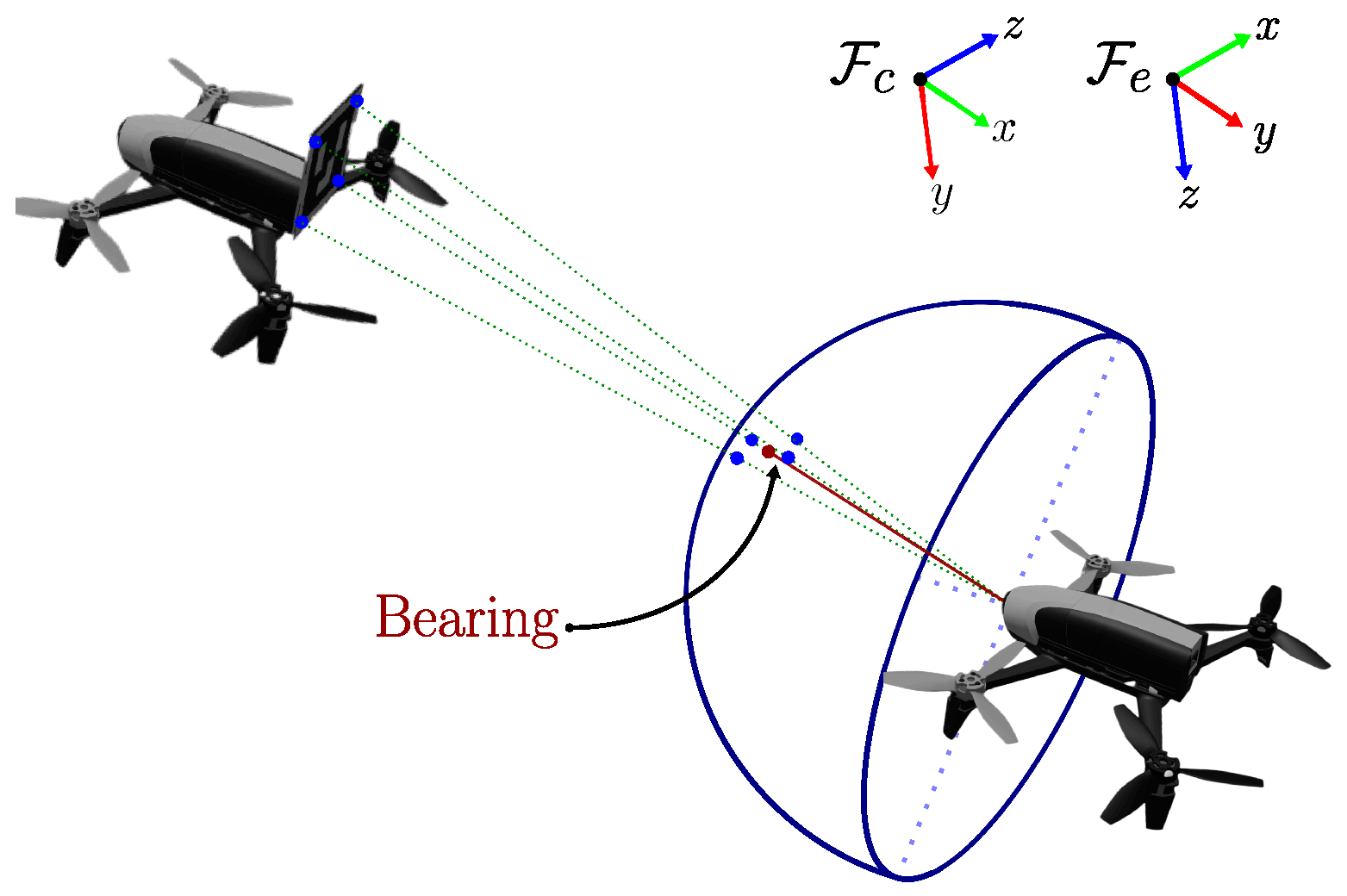



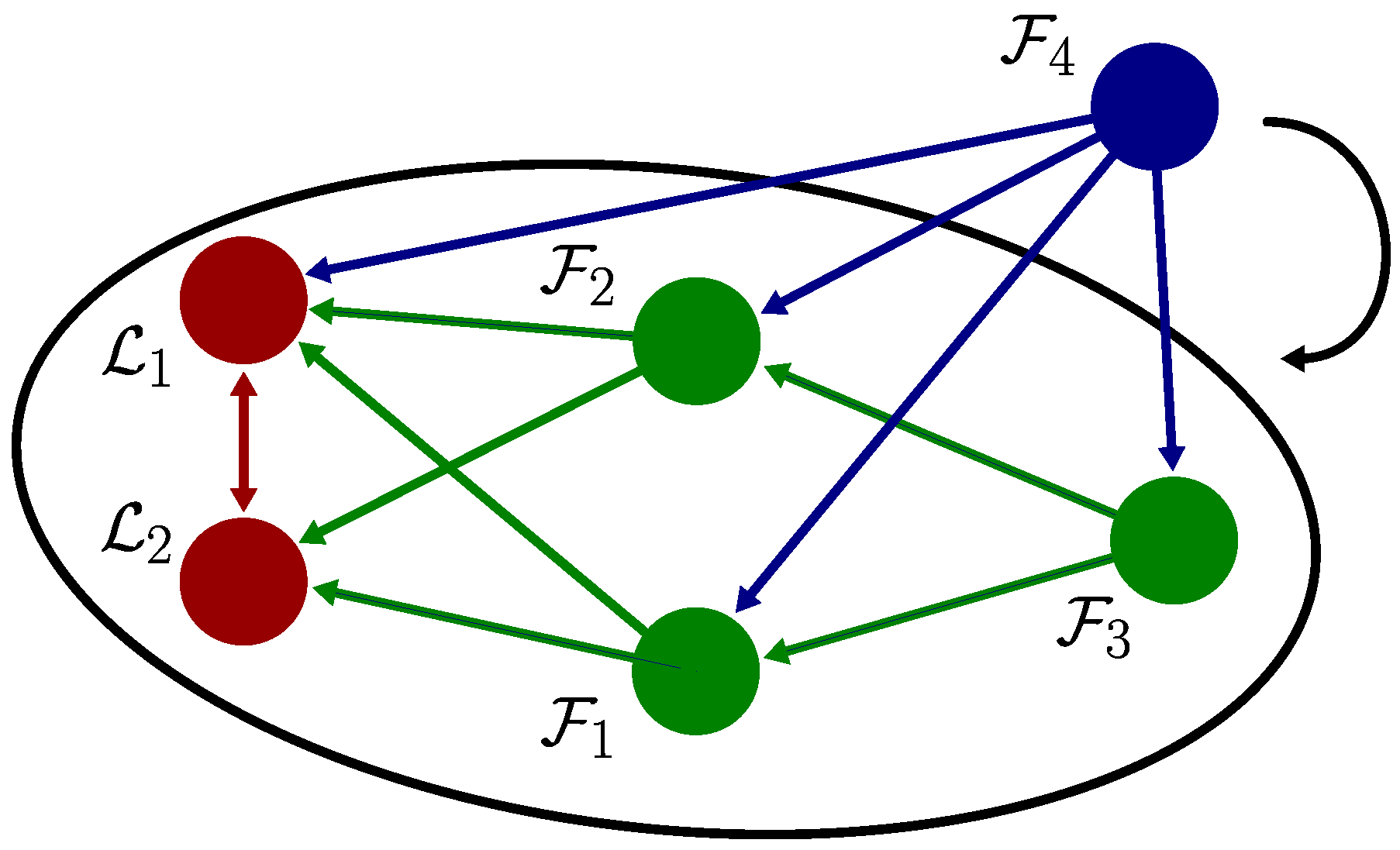


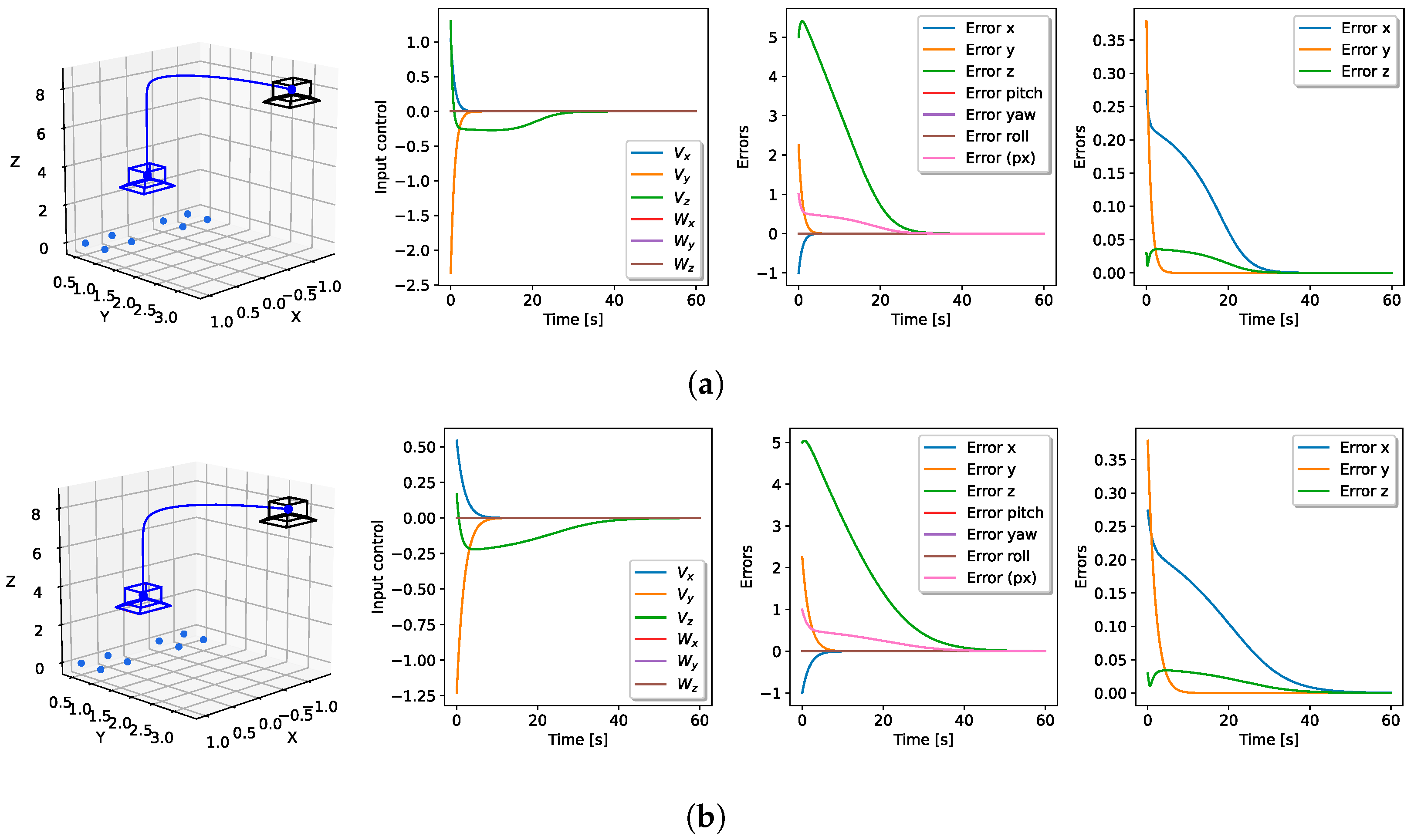


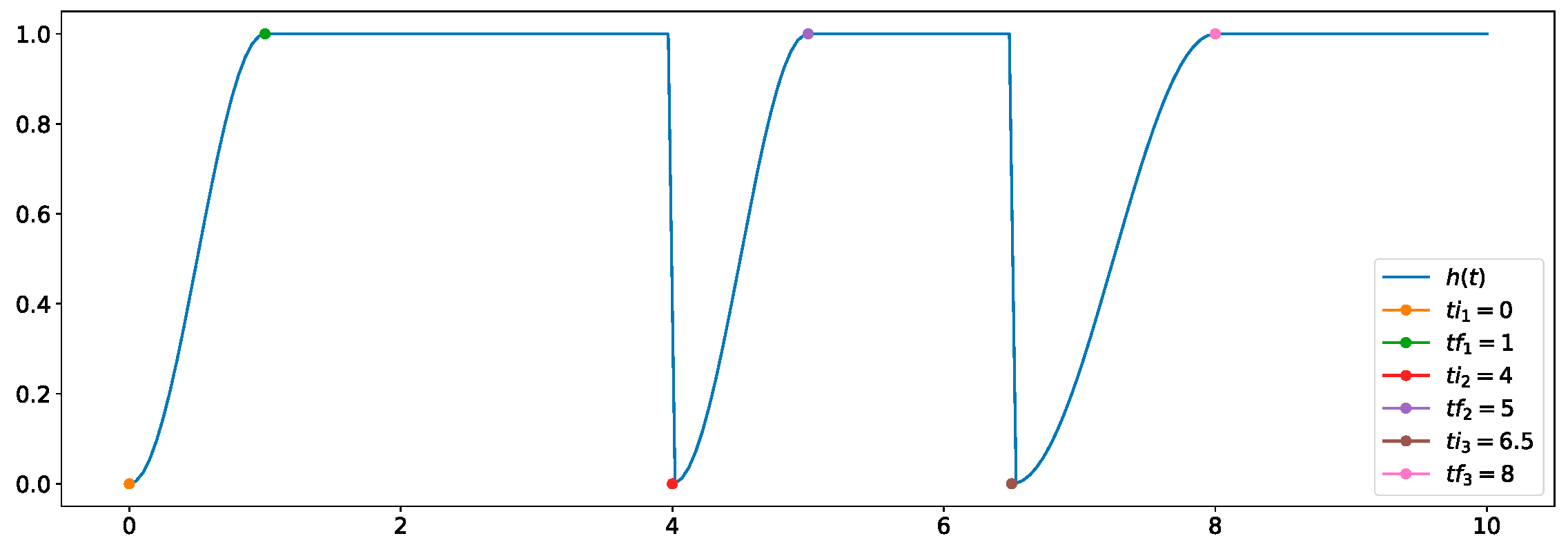

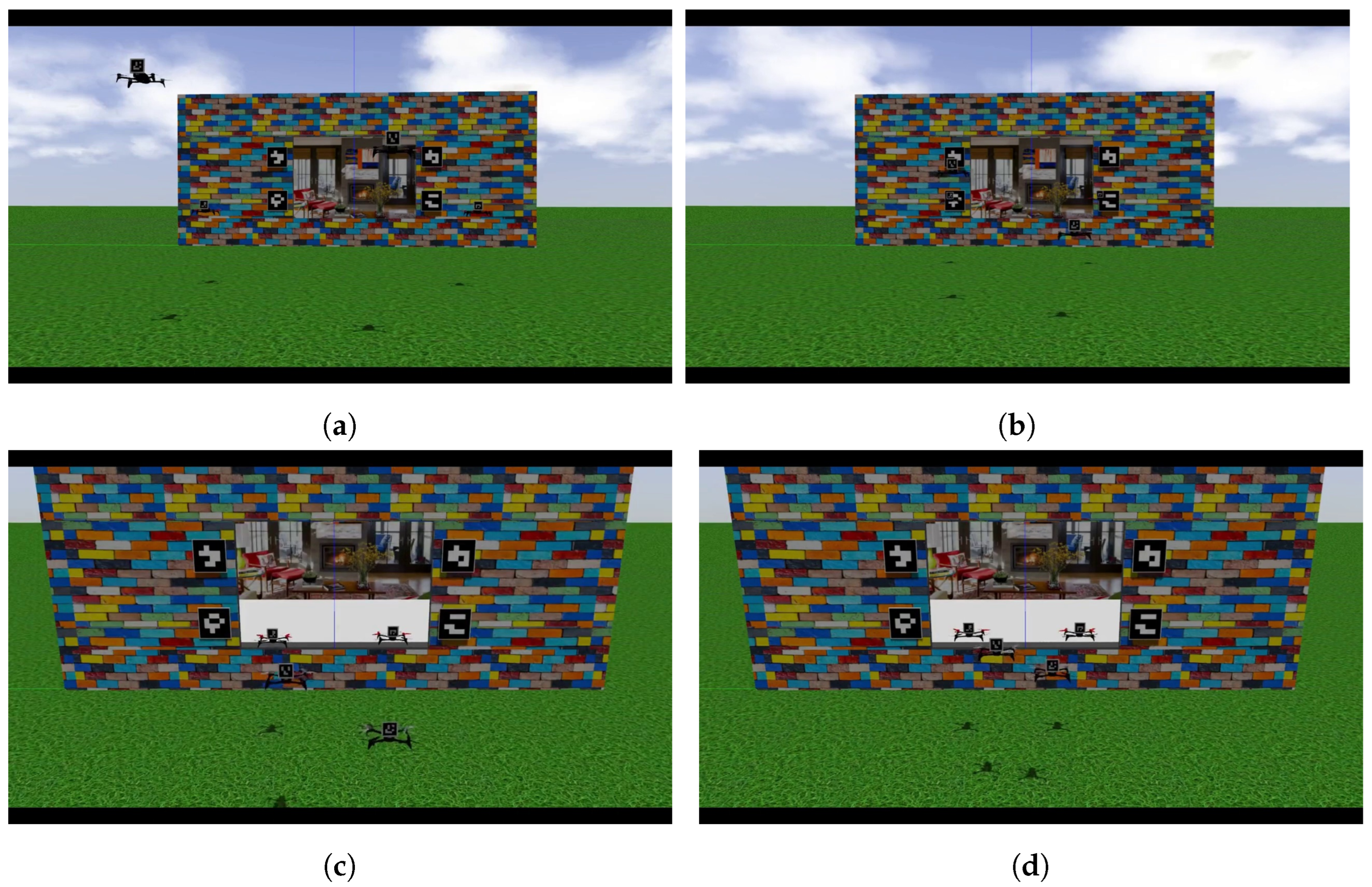

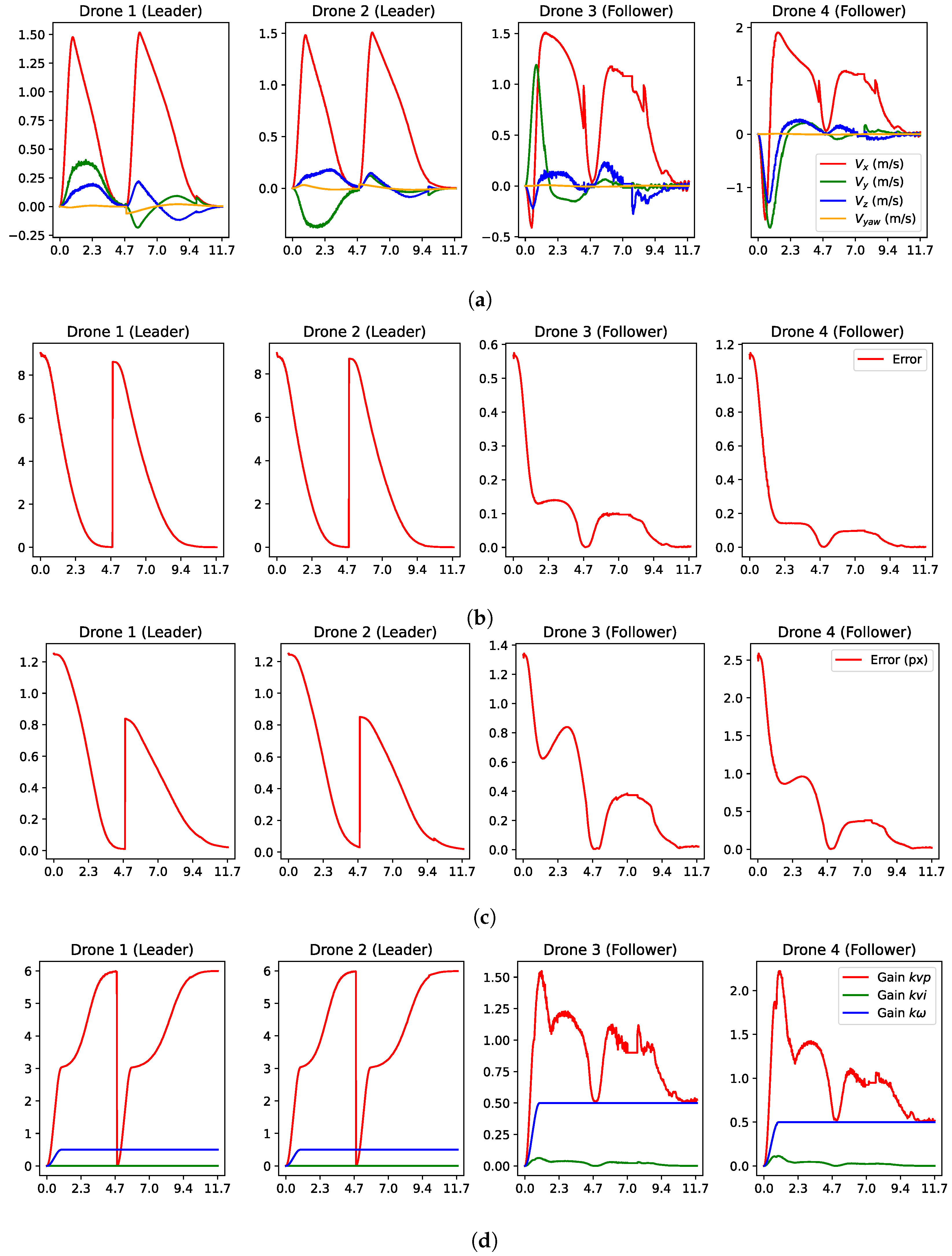

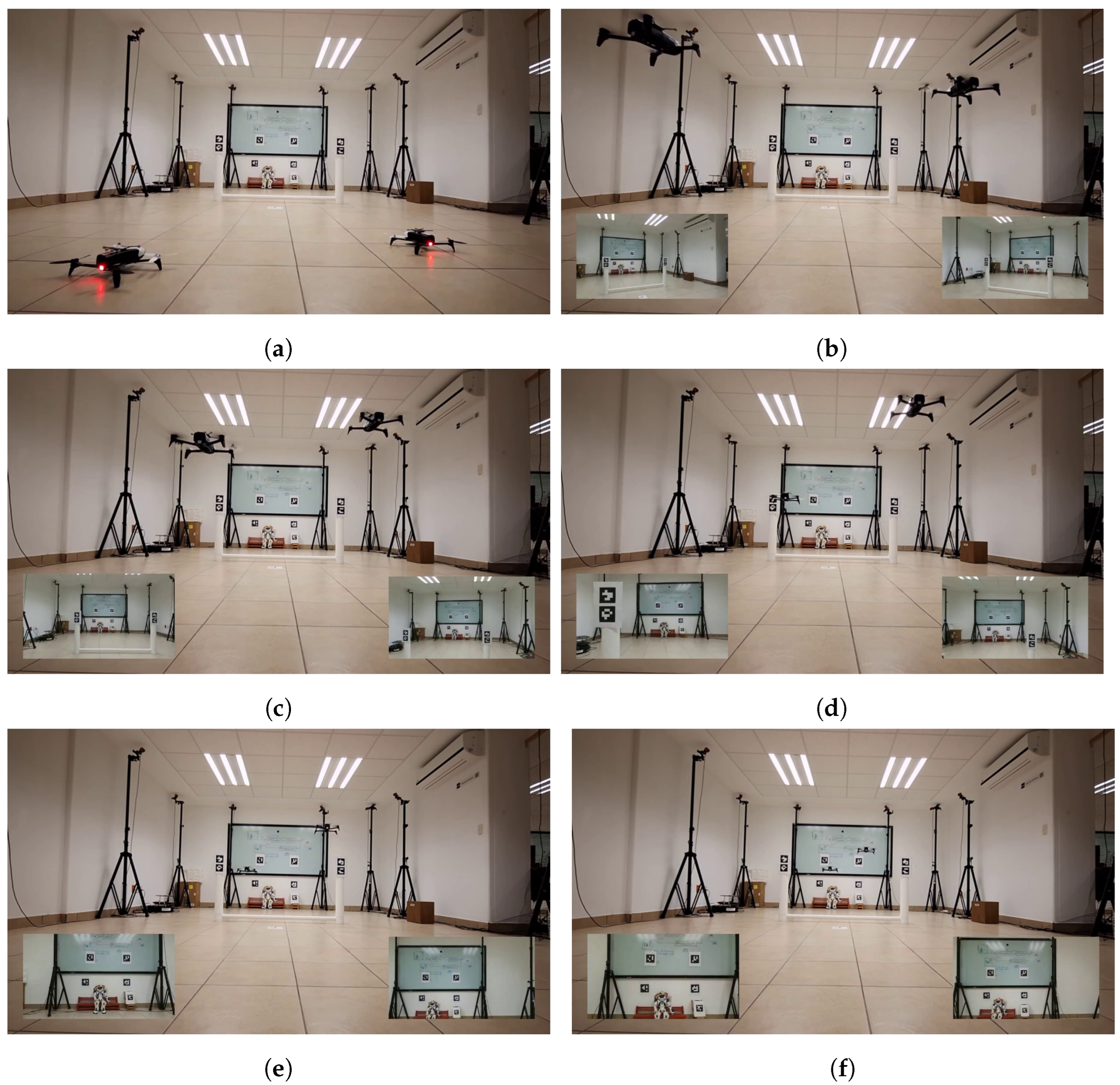
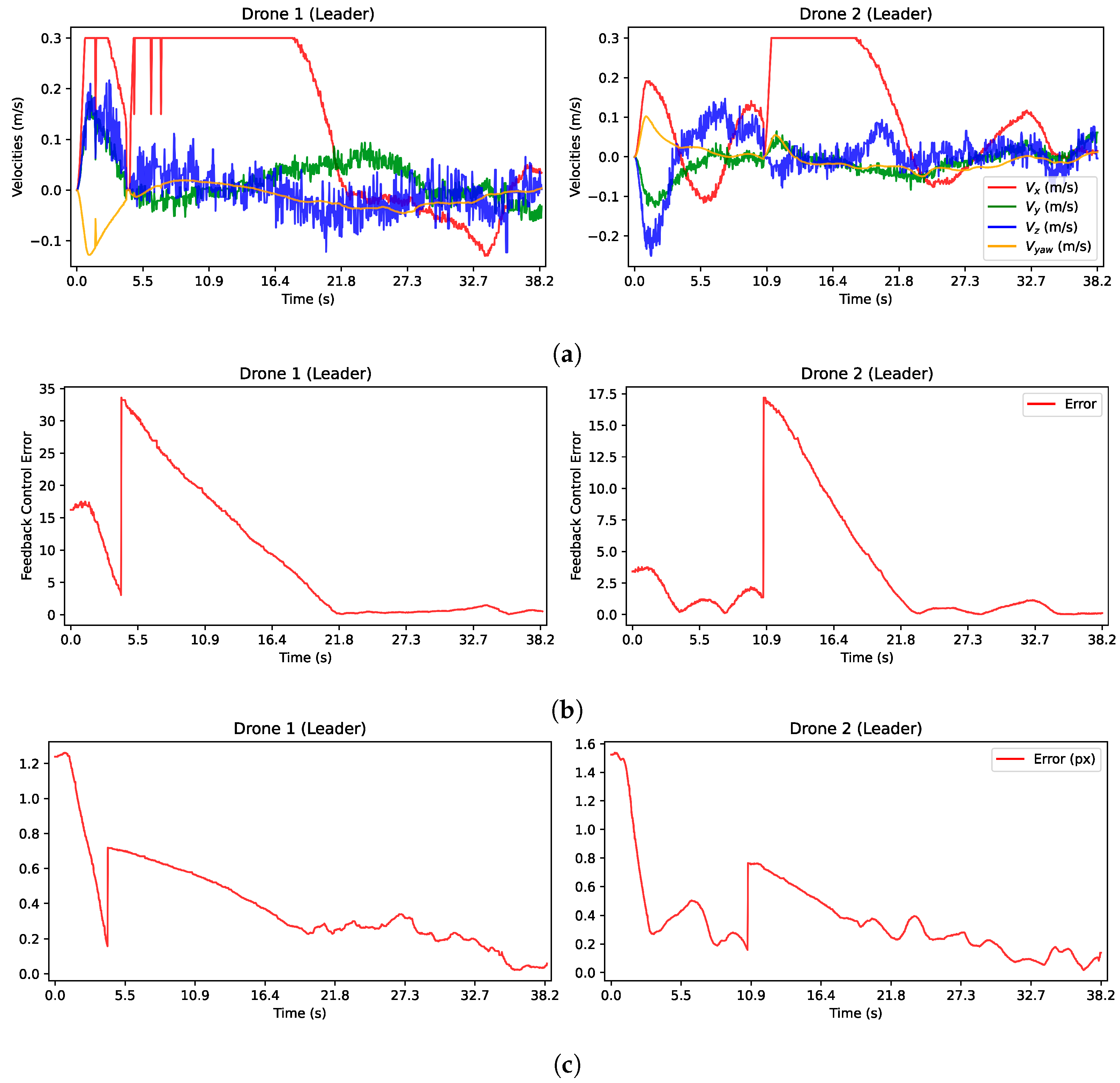
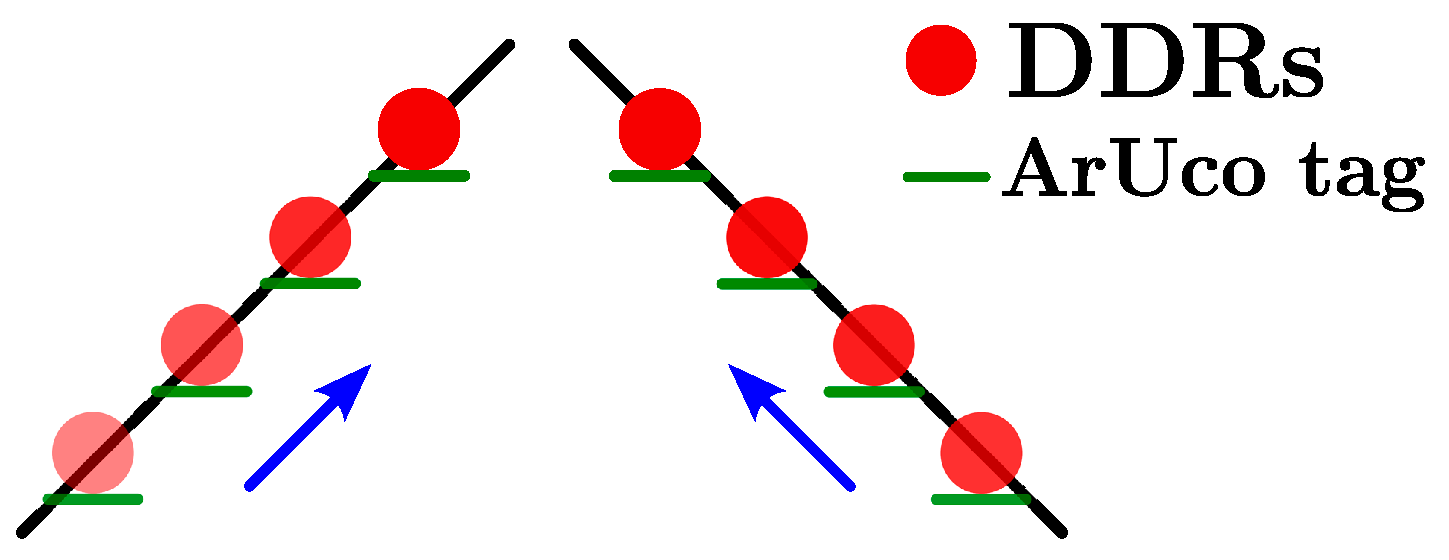

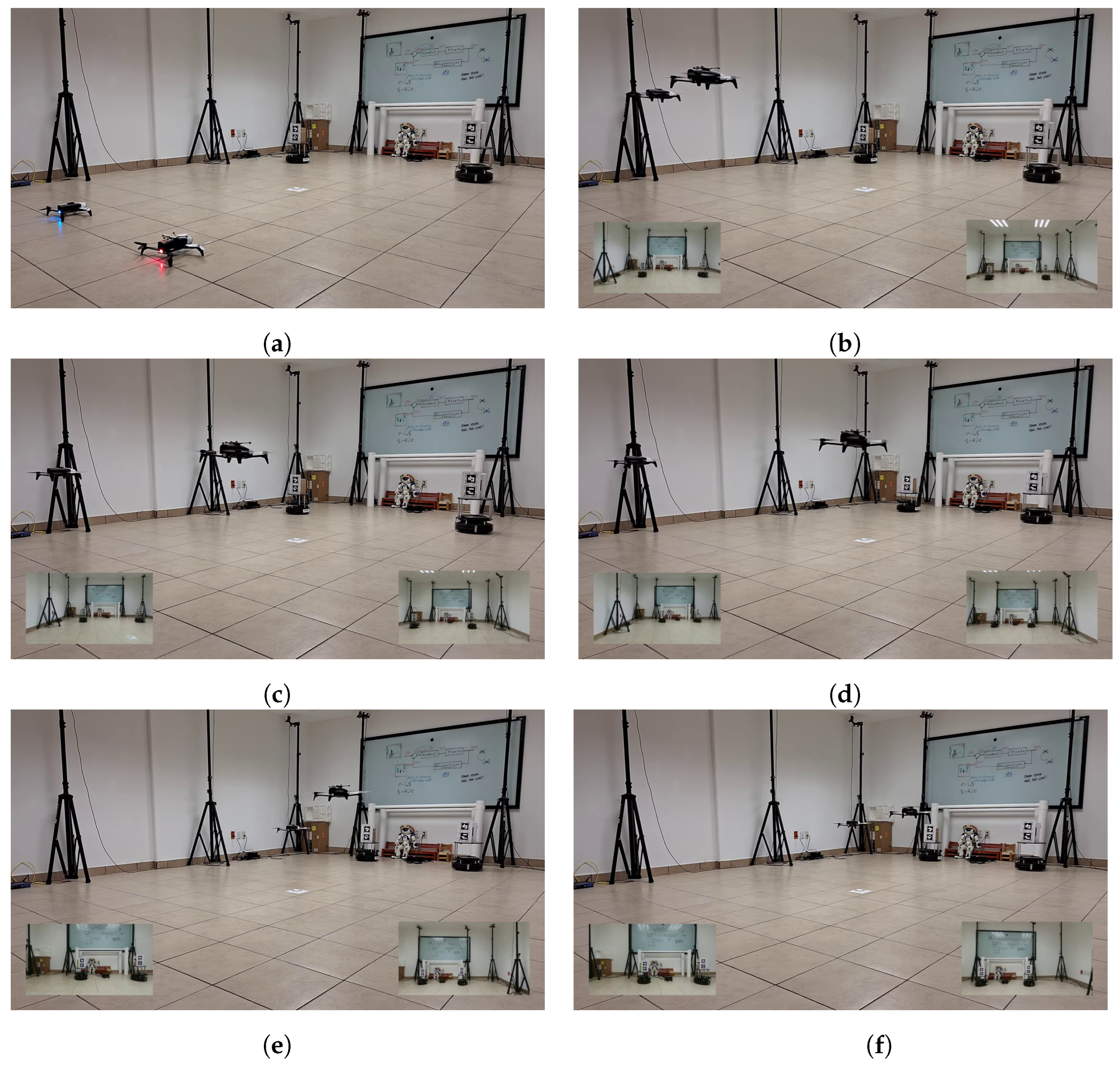
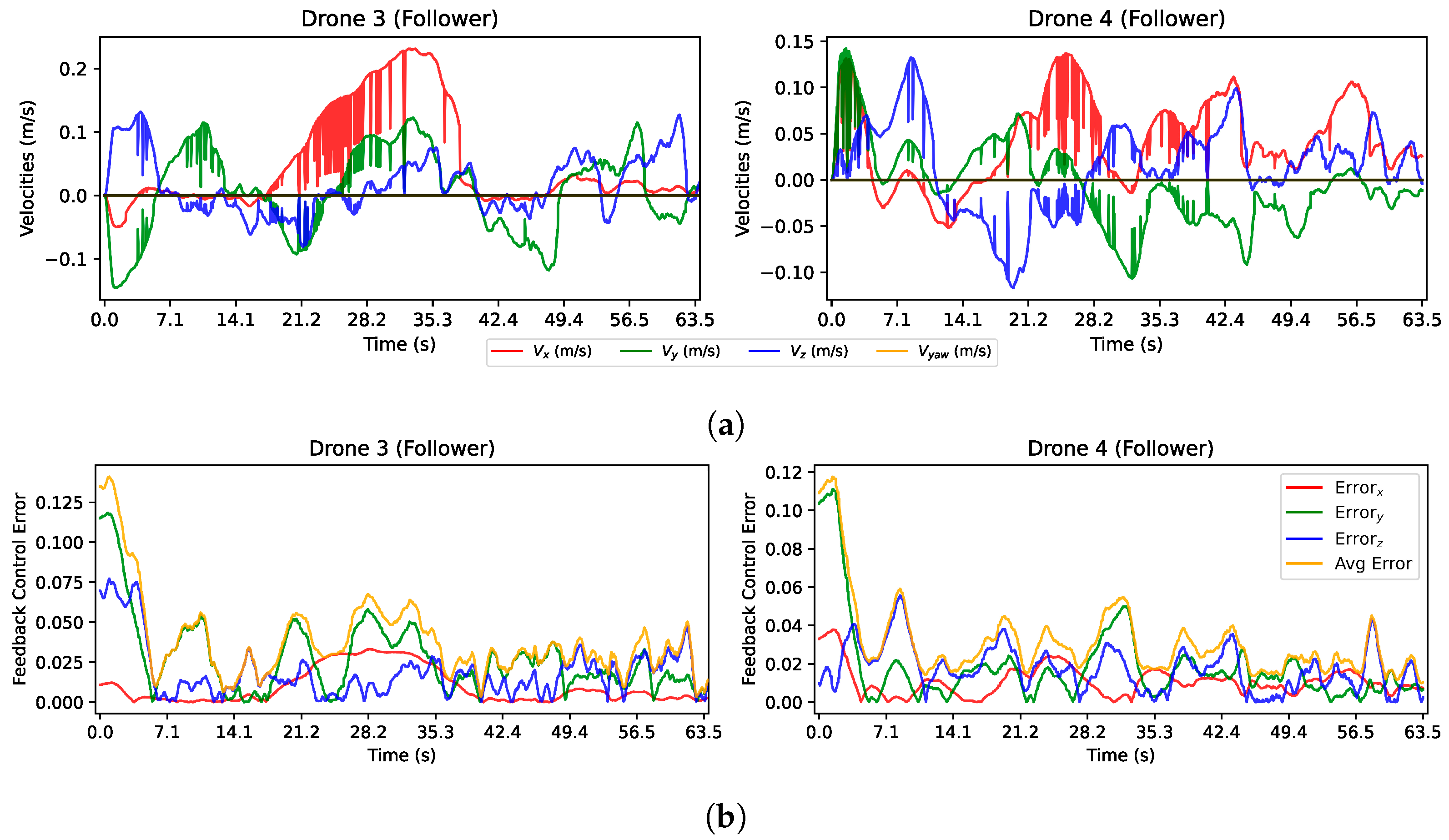

| Initial Pose | Desired Pose 1 in Front of Window | Desired Pose 2 inside Room | |
|---|---|---|---|
| Drone 1 | |||
| Drone 2 | |||
| Drone 3 | |||
| Drone 4 |
| Leader Drones | Follower Drones | |
|---|---|---|
| Adaptive gain | , | , , |
| Adaptive gain | , | , , |
| Adaptive gain | , | , , |
| Threshold change image/finish |
Disclaimer/Publisher’s Note: The statements, opinions and data contained in all publications are solely those of the individual author(s) and contributor(s) and not of MDPI and/or the editor(s). MDPI and/or the editor(s) disclaim responsibility for any injury to people or property resulting from any ideas, methods, instructions or products referred to in the content. |
© 2024 by the authors. Licensee MDPI, Basel, Switzerland. This article is an open access article distributed under the terms and conditions of the Creative Commons Attribution (CC BY) license (https://creativecommons.org/licenses/by/4.0/).
Share and Cite
Ramírez-Parada, D.L.; Becerra, H.M.; Toro-Arcila, C.A.; Arechavaleta, G. Vision-Based Formation Control of Quadrotors Using a Bearing-Only Approach. Robotics 2024, 13, 115. https://doi.org/10.3390/robotics13080115
Ramírez-Parada DL, Becerra HM, Toro-Arcila CA, Arechavaleta G. Vision-Based Formation Control of Quadrotors Using a Bearing-Only Approach. Robotics. 2024; 13(8):115. https://doi.org/10.3390/robotics13080115
Chicago/Turabian StyleRamírez-Parada, David L., Héctor M. Becerra, Carlos A. Toro-Arcila, and Gustavo Arechavaleta. 2024. "Vision-Based Formation Control of Quadrotors Using a Bearing-Only Approach" Robotics 13, no. 8: 115. https://doi.org/10.3390/robotics13080115
APA StyleRamírez-Parada, D. L., Becerra, H. M., Toro-Arcila, C. A., & Arechavaleta, G. (2024). Vision-Based Formation Control of Quadrotors Using a Bearing-Only Approach. Robotics, 13(8), 115. https://doi.org/10.3390/robotics13080115








